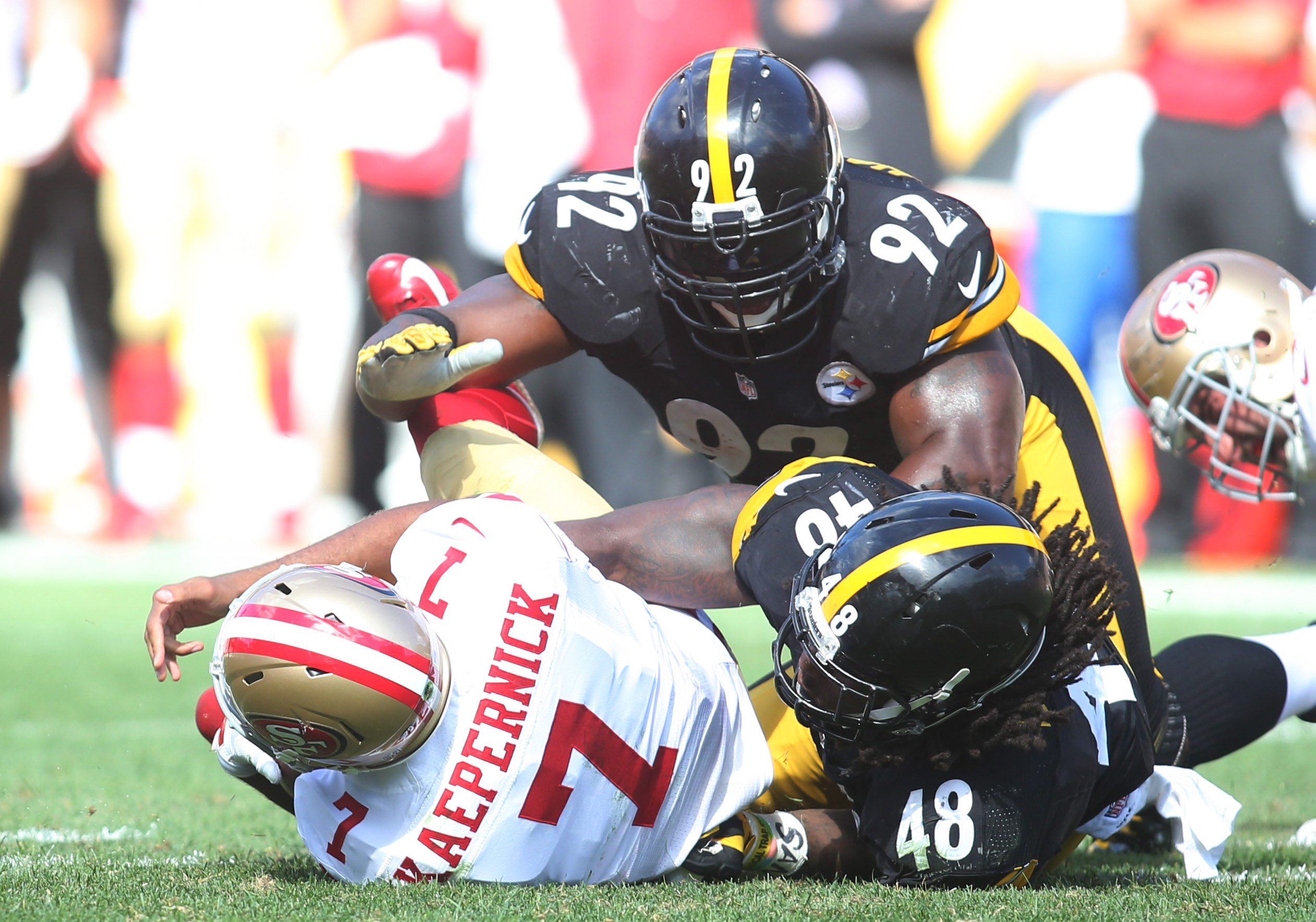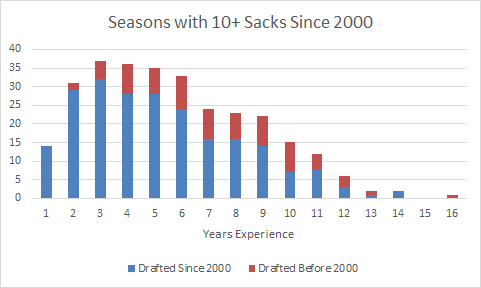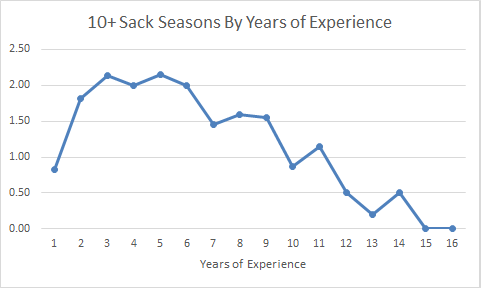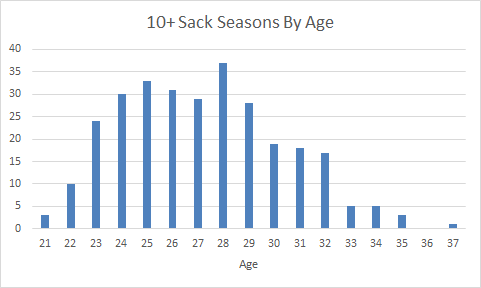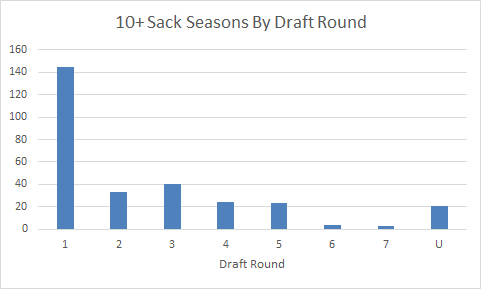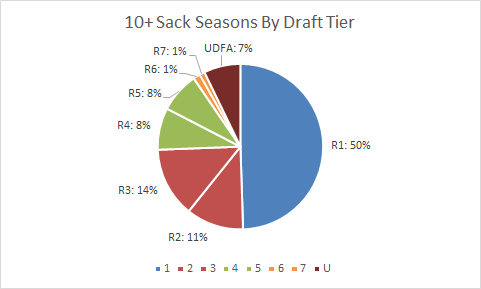Two years ago, the Pittsburgh Steelers had a desperate need at Outside Linebacker heading into the offseason. Their depth chart consisted of Jarvis Jones and a bunch of practice squad players. Due to Jones’ slow development (we’re still waiting), it prompted me to look into how long it generally takes for pass rushers to develop. Most of this research can be found in my initial “Pass Rusher Learning Curve” article. That article, written pre-free agency, ended with this conclusion:
“The question the Steelers front office will have to decide is if it is worth investing almost all of their free agency cap space to put a franchise tag on Jason Worilds, if his production of 7.5 sacks this year warrants a long-term deal, or if they are willing to sacrifice that production in 2015 for a long-term investment of a rookie pass rusher. Drafting a pass rusher in the first round could be the best move in the long-term but historical data shows it is highly unlikely that they will have a significant impact in their first season. Logically, the data shows that if the Steelers want a 10+ sack season out of an outside linebacker in 2015, it is better to invest in a free agent that is in the 4th or 5th year of their career rather than banking on a rare breakout season from a rookie draft pick. However, if the Steelers believe there is an elite pass rusher available in the first round, it would be a wise long-term investment.”

With Jarvis Jones failing to pan out, we are once again back in the boat of needing to add to our edge rushing depth. The current depth chart situation is not as dire as it was in 2015, with the drafting of Bud Dupree in the first round that year. In his two seasons, Dupree has already posted 8.5 career sacks (including 4.5 last season despite playing just 7 games after missing the first half of the season with an injury). In addition to Dupree (who has 2 years left on his rookie deal plus another if the Steelers pick up the 5th year option), the Steelers re-signed the ageless James Harrison to a 2-year deal this offseason. Arthur Moats will be in the last year of his contract in 2017, as will 2015 6th round pick Anthony Chickillo. With the bulk of free agency concluded there aren’t many pass rushers of quality remaining and most teams (including the Steelers) have turned their attention to the Draft.
I pulled data from Pro-Football-Reference’s Database (including Undrafted Free Agents) on double-digit sack seasons in the NFL since 2000. While many things in the NFL have progressed and changed over time, the threshhold of recording 10+ sacks in a season has been relatively constant. In the last two seasons there have been 16 double-digit sack campaigns each year, the exact number same as were recorded in 2001 and 2002. Over the last 17 years there have been 293 double-digit sack seasons with 222 of them recorded by players drafted in this century.
As mentioned in the 2015 article, it is incredibly rare for a rookie to post a double-digit sack season. This feat has only been accomplished 14 times in the last 17 seasons. Chargers rookie Joey Bosa recorded 10.5 sacks in 2016, the first rookie to break the double-digit mark since both Von Miller and Aldon Smith did in 2011. The 2011 draft class was certainly a “generational” group of pass rushers and has recorded 25 double-digit sack seasons in their 6 years in the league. Before 2011, you have to go back to the 2005 Draft Class’s 24 double-digit sack seasons (anchored by DeMarcus Ware, Trent Cole, Justin Tuck, and Shawne Merriman) to find another group close to 2011. Only the 2000 Draft Class has more double-digit sack seasons (27) than the 2011 class, but there is still plenty of time for the 2011 group to surpass that number.
From the chart, it is clear that the most productive years for a pass rusher are generally between the second and sixth of their career. Since 2000, second-year players have recorded nearly double the amount of 10+ sack seasons as first year players. Pass rushers appear to peak in the third year of their career then level off through the 6th season. When the data is normalized by years of experience within the league, it becomes even clearer.
There is also some correlation between age and production. Since 2000, the most double-digit sack seasons have been produced by 28-year old players. There is a fairly consistent learning curve from the youngest players to record a 10+ sack season (21 years old) through 25-year olds. There is also a fairly precipitous drop-off for 30-year olds and for 33-year olds. Age is an important factor when considering pass rushers. When the Steelers drafted Bud Dupree in 2015, he was only 22 years old. Dupree is now entering his Age 24 season in the third year of his NFL career, which is typically when a jump in productivity is seen. Despite his injury which caused him to miss over half the season, Dupree was more productive in his second season than his first with more sacks, tackles, and forced fumbles.
It is worth noting that only a small group of truly special pass rushers were able to maintain a high level of production into the later years of their career. John Abraham posted 8 double-digit sack seasons in his career with 3 of them coming after his 10th year in the league. Julius Peppers was also productive into his 30s with 3 of his 9 double-digit sack seasons coming after his 10th season. Cameron Wake, James Harrison, Jason Taylor, Michael Strahan, and Terrell Suggs also produced multiple double-digit sack seasons after their 10th season in the league. These 7 players account for 17 of the 38 double-digit sack seasons by veterans with at least 10 years of experience.
So where do elite pass rushers come from? The answer here is simple: the first round of the draft. Of the 293 double-digit sack seasons that have been recorded since 2000, nearly half (49.5%) have come from first round picks. Given that undrafted free agents have accounted for 21 double-digit sack seasons, first rounders outnumber all other drafted players (145 to 127) in double-digit sack seasons. Interestingly, with only 7 double-digit sack seasons recorded by 6th and 7th rounders, it seems to be a better draft strategy to sign an undrafted free agent pass rusher rather than selecting one in the last two rounds. The distribution by draft round essentially creates five “tiers” of pass rushers. The best option for finding an elite rusher is obviously in the first round with 49.5% of double-digit sack seasons coming from that group. The second tier is “Day Two” players. Those selected in the 2nd and 3rd rounds have accounted for 24.9% of 10+ sack seasons. The third tier is “Early Day Three.” Fourth and fifth rounders have accounted for 16% of the 10+ sack seasons since 2000. The fourth tier is undrafted free agents, who (as mentioned previously) account for 7.2% of the double-digit sack seasons. Finally, the “Late Day Three” players from the fifth and sixth round account for just 2.4% of double-digit sack seasons. This sets up a nearly perfect depreciation between the tiers. First Rounders are approximately 50% of the group followed by Day Two at approximately 25%, Early Day Three at 16%, UDFAs at 7% and Late Day Threes at 2.5%.
There has been a lot of high-quality work done by folks on other sites regarding the athletic profiles that tend to generate the highest success rates for pass rushers. As a follow-up, I highly recommend checking out Justis Mosqueda’s work on Prodigy Pass Rushers and his benchmarks for new players to achieve the “Prodigy” threshold. Justis’ work essentially concludes that players with better athletic profiles tend to become better pass rushers. The Steelers saw this first-hand with their first round picks over the last four years. Jarvis Jones put up gawdy sack numbers at Georgia, leading the nation in sacks in his final season. But his athletic profile should have been a red flag and his skill set never translated to the NFL.
[protected-iframe id=”b9aac6b5c327f5d08e865ea3a7148905-114320562-84534283″ info=”https://www.mockdraftable.com/embed/jarvis-jones?position=OLB&page=GRAPH” width=”480″ height=”651″ frameborder=”0″ scrolling=”no”]Conversely, Bud Dupree did not have the same production in college that Jones did, but was an athletic freak. Dupree was one of the top-rated EDGE rushers at the 2015 NFL Combine and ranked above the 95th percentile in the 40-yard dash, vertical jump, and broad jump.
[protected-iframe id=”de19409c687805f9e8d2c0ae56b11b84-114320562-84534283″ info=”https://www.mockdraftable.com/embed/bud-dupree?position=EDGE&page=GRAPH” width=”480″ height=”651″ frameborder=”0″ scrolling=”no”]Furthermore, John Ledyard created a metric to conceptualize sack production and determine which players are actually the best pass rushers. John created his metric by watching an insane amount of film and cataloging the “type” of sack a player recorded – whether it was by winning against a blocker or getting a “clean-up” sack by chasing down a scrambling quarterback. I highly recommend reading John’s work, including his breakdown of the top EDGE rushers in the 2017 Draft.
Based on work that was done by ESPN’s Brian Burke (formerly of Advanced NFL Statistics), the 40-yard dash, weight, 3-cone drill, and braod jump are the best indicators for success for outside linebackers. For defensive ends, the broad jump is less important but the top three indicators are the same with 40-yard dash and weight being the top indicators in both.
Relative importance of each event for each position. (Keep in mind this is conditional on being invited to combine.) pic.twitter.com/w8jwcZzGqH
— Brian Burke (@bburkeESPN) March 6, 2017
This is not to say that big seasons by young players are impossible. Since 2000, there have been 42 double-digit sack seasons recorded by players in either the first or second year of their career. Of the 35 players that have recorded double-digit sacks in their first two seasons, only 8 entered the league under 250 pounds and only 3 were under 245. From a height perspective, only 6 of the 35 were shorter than 6’3″ with only two (Dwight Freeney and Elvis Dumervil) listed below 6’2″. Only 6 of the 35 ran a 40-yard dash slower than 4.8 seconds (with only 2 above 4.9). Other numbers are harder to come by, especially for players that had an injury at the combine and did not participate in all of the drills. But it is worth noting that most players were above a 118-inch broad jump, faster than 4.4 seconds in the 20-yard shuttle, and put up at least 20 reps on the bench press.
Filtering this year’s EDGE rusher class by just height (6’3″ or taller), weight (250 lbs or heavier), and 40-yard dash time (under 4.8 seconds), only 9 players that attended the Combine meet these standards. Presumed #1 pick Myles Garrett checks those boxes as well as in the Broad Jump and Bench Press categories. Fringe first rounders TJ Watt of Wisconsin and Jordan Willis of Kansas State also checked all the boxes across the board. Two surprising names on the list that were above the thresholds for all the categories were Northwestern’s Ifeadi Odenigbo and Florida Atlantic’s Trey Hendrickson (who did not participate in the bench press). Ohio’s Tarell Basham and Texas A&M’s Daeshon Hall hit every category except bench press while Illinois’ Dawuane Smoot missed only by 1 inch in the broad jump. Finally, Youngstown State’s Avery Moss hit in the three main categories of height, weight, and 40 time but missed in the other three categories of bench press, broad jump, and 20-yard shuttle.
In retrospect, 2013 was clearly an outlier year for pass rushers. The class as a whole was incredibly shoddy with the exception of Top 5 pick Ziggy Ansah. The red flags were there with Jarvis Jones as he failed to reach the benchmarks for early success in all six categories identified above. With that draft now squarely in everyone’s rearview mirror (and most of the first round picks now gone from their original teams), the focus is on the 2017 class. This year’s class does have a deep crop of pass rushers, and the Steelers clearly have a need at the position. Picking 30th in the first round also decreases the probability that one of the elite talents will fall to them. That being said, the first round still remains the best place to select an elite pass rusher. If the Steelers do select an edge rusher this year, fans need to remember to temper their expectations as it is a rarity for rookies to have an immediate break-out season. That being said, big things should be expected of Bud Dupree as he is now entering that “sweet spot” of his career where his age and experience line up with where a jump in production is typically seen.
Add The Sports Daily to your Google News Feed!
